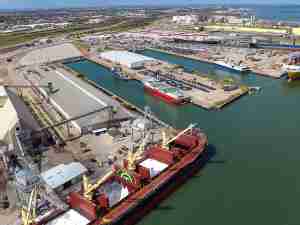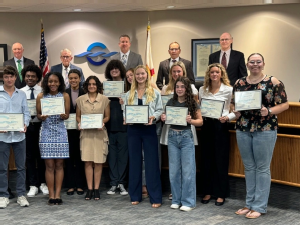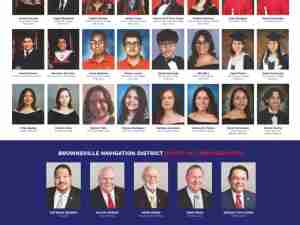At their winter meeting in Washington, DC last week, the American Great Lakes Ports Association adopted the following policy agenda for 2024. AGLPA works to promote public policies that enhanced maritime commerce on the Great Lakes and St. Lawrence Seaway System.
Distribute of Port Infrastructure Grants Equitably
The Port Infrastructure Development Program (PIDP) is the primary source of federal investment in the nation’s port infrastructure, such as dock reconstruction, rail improvements, road access, storage expansion, and modernization of cargo handling equipment. The program is managed by the Maritime Administration, an agency of the U.S. Department of Transportation.
Port infrastructure grants are not being distributed equitably. Last year, the U.S. Department of Transportation distributed $653 million under this program and Great Lakes ports only received 2% of the funds. Over the 5-year life of the program, Great Lakes ports received only 8% of funds distributed. By comparison, West Coast received 38.5% and East Coast ports received 34%.
Congress should require the U.S. Department of Transportation to distribute funds in an equitable manner between regions of the United States.
Improve Great Lakes Icebreaking Services
Heavy ice threatens the reliability of Great Lakes-Seaway transportation early and late in the navigation season. The U.S. Coast Guard is responsible for icebreaking services to ensure navigation and enhance safety. The agency’s Great Lakes icebreaking fleet consists of nine vessels: six 140-foot icebreaking tugs, two buoy tenders, and the heavy icebreaking cutter Mackinaw. Severe winter weather is placing a stress on these assets. In 2022 Congress authorized the construction of a new heavy icebreaking cutter. The project’s estimated cost is $350 million. Both the House and Senate Appropriations Committees have approved $55 million in FY24 to begin construction of the new vessel. Congress should complete work on the FY24 appropriation and include $55 million in FY25 to continue construction.
Eliminate the Corps of Engineers’ Great Lakes Navigation Maintenance Backlog
According to the Corps of Engineers, over the next 5 years Great Lakes navigation channels will require $550 million of dredging to maintain authorized dimensions. Breakwaters and other federal navigation structures will need $768 million in repairs, and the existing Soo Locks will require $300 million in upgrades.
Maintenance activities for coastal and Great Lakes navigation are funded from the Harbor Maintenance Trust Fund (HMTF), which is financed by the Harbor Maintenance Tax – a fee collected from users of the maritime transportation system. Although the tax generates adequate revenue, over the last two decades Congress has restricted spending on harbor maintenance due to budgetary constraints. The result has been crumbling infrastructure and harbors choked with sand and silt.
The Water Resources Development Act of 2020 provides special budgetary treatment for amounts appropriated from the Harbor Maintenance Trust Fund (HMTF) – up to a cap defined in law. This provision is meant to eliminate budget constraints and allow full use of Harbor Maintenance Tax revenue. It is also meant to spend-down the trust fund’s $10 billion surplus balance. The cap for FY2025 is the sum of: 1) amounts deposited into the HMTF from tax revenue two years prior, plus 2) $900 million. This calculation yields $3.087 billion. Great Lakes ports urge Congress to appropriate $3.087 billion from the HMTF for the Corps’ deep draft coastal navigation operation and maintenance activities.
Complete the Soo Lock Project
Owned and operated by the Army Corps of Engineers, the lock complex at Sault Ste Marie, Michigan (“Soo Locks”) enables ships to navigate the St. Marys River, which connects Lake Superior and Lake Huron. Through this critical infrastructure, Great Lakes commercial vessels carry iron ore and other raw materials that feed the nation’s steel industry, agricultural products destined for export markets, and low sulfur coal fueling the region’s electric utilities. Unfortunately, the lock infrastructure is old and in need of repair and replacement. Congress originally authorized construction of a new large lock at Sault Ste Marie in the Water Resources Development Act of 1986. The project was reauthorized in 2022 at a total cost of $3.2 billion. The project is currently under construction and has received a total of $1.9 billion of federal and state funds to date.
Congress and the Administration should keep the project moving forward and provide adequate funding in the FY2025 Energy and Water Development Appropriations Bill to enable the project to remain on schedule for completion in 2030.
Improve U.S. Customs and Border Protection Services
In recent years, Great Lakes ports have been working to develop new business in two distinct areas: containerized cargo shipping, and passenger cruise tourism. These new business sectors have presented a challenge for U.S. Customs and Border Protection (CBP). The inspection and processing of shipping containers and passengers is more complicated than the processing of traditional Great Lakes bulk cargoes. Both require unique staffing, equipment, and facilities. CBP officials have explained that they face both funding and staffing limitations and have denied service at some ports, limiting economic growth.
CBP’s current service model discourages the development of new commerce and jobs at Great Lakes ports. In a real sense, it asks commerce to shape itself to the inspection regime, rather than shaping the federal CBP inspection service to the efficient flow of commerce.
Congress should provide more funding for CBP services, including staff, inspection facilities, and capital costs at seaports. To accomplish this goal, Congress should enact H.R. 6409, the CBP Space Act. This legislation allows revenue generated by the federal Merchandise Processing Fee (MPF) to be used for CBP capital needs at ports. Finally, Congress should direct CBP to develop a small port, low volume, and seasonal clearance model that accommodates the unique conditions and scale of the Great Lakes cargo and cruise market.
Harmonize the Seaway Navigation Season with the Soo Locks
The opening and closing dates of the St. Lawrence Seaway vary from year to year due to weather conditions and the demands of commerce. The system’s locks have opened as early as March 20 and as late as March 31. The closing date has ranged from December 24 to January 5. To enhance the reliability of the shipping system, attract new cargoes and foster employment in the maritime sector, the United States and Canada should harmonize the Seaway’s opening and closing dates with those of the Soo Locks in northern Michigan. Doing so would establish a fixed navigation season for the entire Great Lakes navigation system from March 25th – January 15th.
Stand Up the Great Lakes Authority
In 2022 Congress enacted legislation to create the “Great Lakes Authority,” a new economic development agency for the Great Lakes Region. The authority is to be governed by a nine-member board with a federal co-chair appointed by the President, and one board member appointed by each of the eight Great Lakes Governors. The authority may hire an executive director and staff as are necessary to carry out its duties. Congress authorized the authority to receive up to $30 million/year in annual appropriations.
The GLA will focus on both economic and infrastructure development and may provide grant funding to worthwhile projects. While the authority’s mission is broad, it has a specific mandate to “develop the transportation infrastructure” of the region. This includes port infrastructure. AGLPA supported enactment of this important legislation and urges the White House and Governors to move quickly to appoint the authority’s board. Similarly, AGLPA urges Congress to appropriate start-up funds in the FY2025 Energy and Water Development Appropriations Bill.
Reform Great Lakes Pilotage
All ocean-going ships operating on the Great Lakes and St. Lawrence Seaway are required by law to hire a U.S. or Canadian marine pilot to assist with navigation.
The Great Lakes Pilotage Act of 1960, and its associated regulations, give form and structure to the pilotage regime in the sections of the Great Lakes under U.S. jurisdiction. In its current state the system is a regulated monopoly. Ship owners (the consumer) are required by federal law to employ pilots. Since there is only one pilotage service provider authorized in each geographic area, an effective monopoly exists. The Coast Guard exercises broad regulatory oversight over all aspects of Great Lakes pilotage, including the setting of fees.
Under Coast Guard management, Great Lakes pilotage has become a runaway cost for international trade on the Great Lakes-St. Lawrence Seaway navigation system. In the last ten years (2014-23), the overall cost of U.S. pilotage on the Great Lakes has tripled ($12.8 million – $37 million). Individual pilot compensation as set by the Coast Guard has soared to $440,658. Unreasonable costs threaten the competitiveness of international commerce on the Seaway system.
Congress should update the Great Lakes Pilotage Act with the goal of maintaining safety, increasing efficiency, reducing costs, and improving the competitive position of the navigation system.
Maintain Safe and Efficient Commerce Through the Chicago Area Waterway System
Constructed between 1887-1922, the Chicago Area Waterway System (CAWS) provides a connection between the inland river navigation system and the Great Lakes, facilitating the movement of maritime commerce and recreational boating. The waterway also serves an important role in the sanitation and flood control system serving Chicago and Northwest Indiana. Inland river barge transportation through the CAWS serves the Ports of Chicago, Milwaukee, Burns Harbor, Indiana Harbor and Gary.
To control the migration of non-native Asian Carp and other aquatic nuisance species, some have proposed physical separation and/or modification of the waterway. AGLPA opposes closure or extended disruption of navigable waterways in the Great Lakes region.
AGLPA supports efforts to prevent migration of non-native Asian Carp and other aquatic nuisance species between the Great Lakes and Mississippi River basins, while at the same time protecting the vital role of maritime commerce. AGLPA urges the federal government to continue to pursue a comprehensive approach to this problem, including operation and maintenance of electronic barriers in the canal near Lockport, Illinois; monitoring and sampling of fish populations; chemical and biological controls; expanding contract fishing, developing commercial markets for Asian Carp, and coordination with the Government of Canada to police illegal transport of Asian Carp in the aquaculture industry. AGLPA also supports continued development and implementation of a plan by the Corps of Engineers to modify the Brandon Road Lock in Joliet, Illinois, to include a series of fish deterrents. AGLPA opposes any new plan elements that threaten the health and safety of mariners or impede the efficient movement of commerce.
Fund the Great Lakes Restoration Initiative
The Great Lakes include 20 percent of the world’s surface freshwater and host a diverse ecosystem of aquatic and terrestrial life. Launched in 2010, the Great Lakes Restoration Initiative (GLRI) was created to restore and maintain the chemical, physical and biological integrity of the Great Lakes Basin ecosystem. The GLRI seeks to replace earlier piecemeal approaches to ecosystem restoration with a single comprehensive program. The Environmental Protection Agency (EPA) leads and administers the restoration initiative and partners with multiple federal agencies to carry out restoration projects.
As stakeholders in a healthy, productive ecosystem, Great Lakes ports support the GLRI program and urge Congress to approve $450 million in the EPA’s FY2025 budget – the full, authorized amount.
Provide State Assistance for Port Infrastructure
Great Lakes Seaway shipping supports 147,000 jobs in the eight Great Lakes states. This fact demonstrates that ports are important economic drivers. While state governments invest heavily in highways, airports, rail and transit, port funding is modest or non-existent.
To the contrary, federal investment in port infrastructure has exploded in the last two years. If Great Lakes states are to capture their fair share of these funds, port communities will require state assistance to meet non-federal cost sharing requirements.
In late 2015, a regional maritime strategy released by the Great Lakes St. Lawrence Governors and Premiers called for port investment by states. Great Lakes states should follow-up on that recommendation and enact harbor assistance programs.










